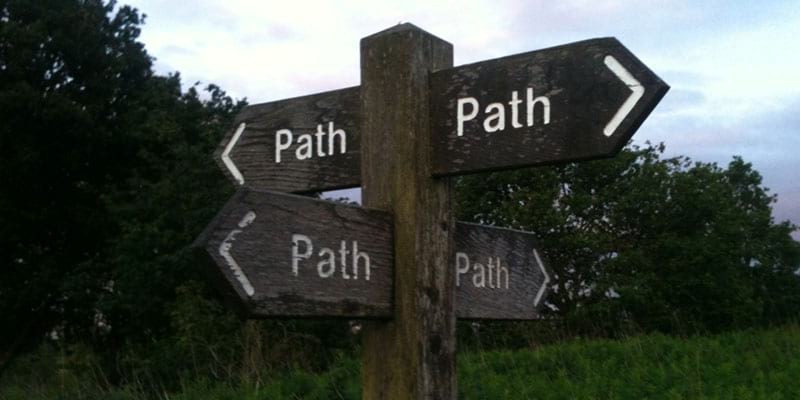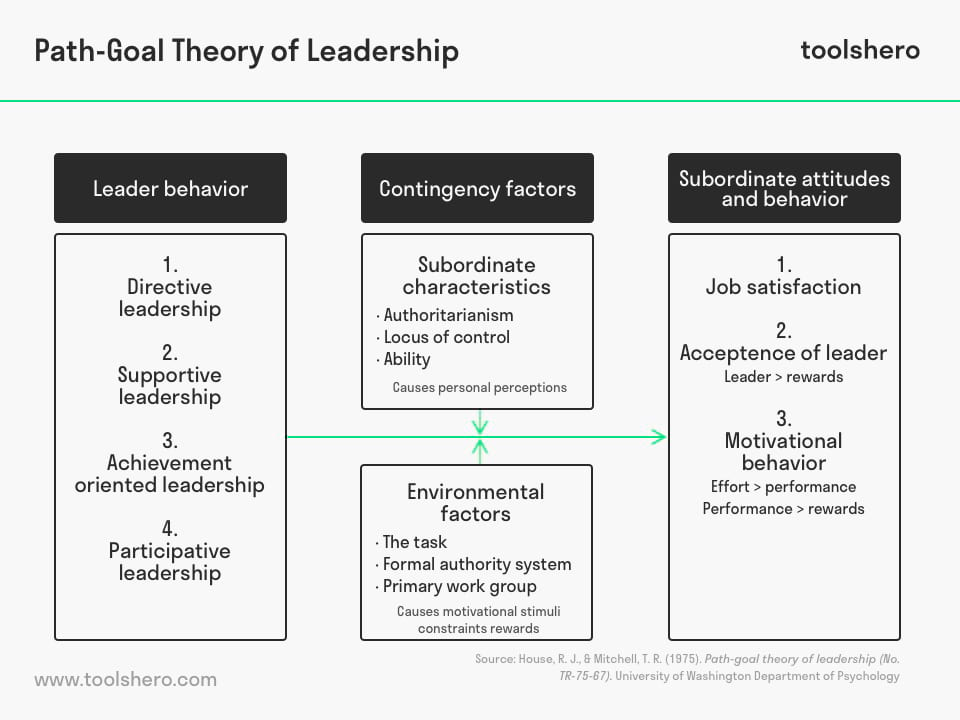Path Goal Theory of Leadership

Path-Goal Theory of Leadership: this article describes the Path-Goal Theory of Leadership, developed by Robert J. House and Terence R. Mitchell in a practical way. It covers what it is, which leadership behaviours and styles come with it and how to apply the path-goal theory. After reading this article you will understand the definition and basics of this powerful leadership tool.
What is the Path-Goal Theory of Leadership?
The Path-Goal Theory is a leadership theory that was developed in the ’70s of the last century by American management guru and expert in the field of leadership in various cultures, Robert J. House and American organisational expert Terence R. Mitchell.
In this leadership theory, they assume that a leader complements her or his employees and compensates for their shortcomings. The task-oriented elements of the Path Goal Theory match situational leadership.
In the Path-Goal Theory of Leadership, effective leaders give their employees, dubbed ‘followers’ by House and Mitchell, a clear path they must follow to achieve their goals. This type of supervision removes pitfalls and barricades.

Figure 1 – Path-Goal Theory of Leadership (House & Mitchell, 1975)
The Path-Goal Theory provides ways for leaders to encourage and support their employees in achieving their goals. That also includes rewards.
Path-Goal Theory of Leadership Behaviour
Motivation is an important component in leadership and plays a significant role in the Path-Goal Theory of Leadership. After all, it’s about how leaders can motivate their employees in achieving their smart goals within their work environment.
House and Mitchell posit that leaders can increase motivation and happiness at work by rewarding their employees. Additionally, they must clarify which path to choose to work towards the goal and provide focus for their employees by coaching them and keeping them on the right track within their work environment.
This will only increase work enjoyment. According to this leadership theory, leaders must focus on various types of leader behavior / leadership behaviour. This may differ per situation and employee, as long as they provide focus and support. This allows leaders to work on the department’s goals, but also unite these with the organisation’s goals.
4 Leadership Styles
The right leadership style depends on the situation and the employees. The chosen leadership style is only acceptable when it’s accepted by her or his employees and motivates and satisfies them. It’s the leader’s task to facilitate, coach and reward her or his employees. The Path-Goal Theory identifies four leadership styles:
1: Directive leadership
In this leadership style, the leader knows exactly what must be done, how tasks must be performed and what the deadline is. This means that he provides her or his employees with clear guidelines with regard to the processes and tells them what’s expected of them and how best to carry out their tasks.
The employees get close supervision. Therefore, this management style is more suited for very inexperienced employees who need guidance and to be checked on regularly.
2: Supportive leadership
In this leadership style, the supportive leader pays a lot of attention to the needs and well-being of her or his employees. The leader behavior is characterised by being friendly and empathetic. He or she treats her or his employees with respect and supports them when necessary.
This management style is useful in situations in which the employee has a (personal) problem, doesn’t believe in himself or is temporarily demotivated.
3: Achievement-oriented leadership
In this leadership style, the leader sets challenging goals. He or she expects achievements on the highest level from her or his employees and trusts their ability to handle this. He or she forces them to display excellent work achievements and constant improvement and has the utmost confidence in the abilities of her or his employees.
Employees who are able to work fully independently and have problem-solving capacities are suitable for this management style.
4: Participative leadership
In this leadership style, the leader deems it very important to work with his employees and include their ideas and opinions in decisions. This means she or he is open to consultation and discussion, and includes suggestions from her or his employees in her or his decision-making process.
The leader will deploy this leadership style particularly when employees are highly involved and have specialist knowledge. Their advice is invaluable to the leader.
Application of Path-Goal Theory
The Path-Goal Theory of Leadership assumes that leaders are flexible and can adapt their leadership style to the situation. This is influenced by the environment, the work and the characteristics of the employees. Employees’ level of experience, ability to work independently and motivation also play a role.
It’s up to the leader to adopt a stronger or better approach. When clarifying the path that leads to the final goal, leaders can choose to provide clear guidelines or stick to vague hints and let the rest depend on the employee. In case of hurdles that lead to stagnation, they can offer employees a helping hand.
Path-Goal Theory : Investigating Motivation
The Path-Goal Theory ensures that leaders can improve the output of their organisation by influencing their employees and guiding them to their goal. To know what motivates their employees, it’s wise to investigate the following characteristics:
- Are the employees intrinsically or extrinsically motivated? Extrinsic refers to the fact that the employee is mainly focused on making money and receiving bonuses, while intrinsic motivation relates to feeling appreciated in the form of extra responsibility, working independently and trust.
- Does the employee have a strong need for connection in the group and does she or he prefer to work in a team, or does she or he require a high level of independence?
- Would the employee like to carry out his work independently or is it important to her or him to be directed and checked?
By answering these questions, leaders are better able to understand the motivational needs of their employees and adjust their leadership style accordingly.
It’s Your Turn
What do you think? What is your experience with the Path-Goal Theory of Leadership? Do you recognize the practical explanation or do you have more additions? What are your success factors for encouraging and supporting employees in achieving their goals?
Share your experience and knowledge in the comments box below.
More information
- Evans, M. G. (2002). Path-goal Theory of Leadership. Leadership, 115-138.
- House, R.J. (1971). A Path-Goal Theory of Leader Effectiveness. Administrative Science Quarterly. 16, 321-328.
- House, R. J., & Mitchell, T. R. (1975). Path-goal theory of leadership (No. TR-75-67). University of Washington Department of Psychology.
- Sagie, A., & Koslowsky, M. (1994). Organizational attitudes and behaviors as a function of participation in strategic and tactical change decisions: an application of path–goal theory. Journal of Organizational Behavior, 15(1), 37-47.
How to cite this article:
Mulder, P. (2018). Path Goal Theory of Leadership (House & Mitchell). Retrieved [insert date] from Toolshero: https://www.toolshero.com/leadership/path-goal-theory/
Original publication date: 03/05/2018 | Last update: 09/15/2023
Add a link to this page on your website:
<a href=”https://www.toolshero.com/leadership/path-goal-theory/”>Toolshero: Path Goal Theory of Leadership (House & Mitchell)</a>













2 responses to “Path Goal Theory of Leadership”
Succinct and easy to understand.
Thank you for your feedback Zakaria. I am glad that you found the article easy to understand.